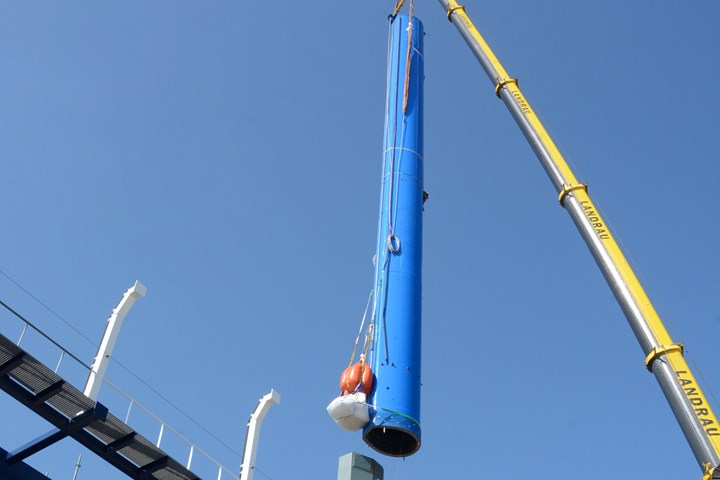Hexcel prepregs power cleaner ocean transport with Chantiers de l’Atlantique Silenseas project
HexPly supplied M9.6 carbon fiber prepregs for a 34-meter-high cruise ship mast. Silenseas production scale-up objectives for future vessels intend for the development of three 66-meter-high carbon fiber masts.
Share
Read Next

Erection of the 34-meter mast on a Silenseas cruise ship vessel. Photo Credit: Hexcel, Silenseas consortium
Hexcel (Stamford, Conn., U.S.) has announced the successful completion of a 34-meter HexPly carbon fiber prepreg mast for the Chantiers de l’Atlantique (Saint-Nazaire, France) Silenseas project. The HexPly M9.6 prepregs supplied to the Silenseas consortium’s mast section manufacturers reportedly satisfied all project quality, mechanical and processing performance targets, while delivering a scalable, cost-competitive composite solution to power cleaner, more sustainable transportation using commercial vessels.
The Silenseas project was started by Chantiers de l’Atlantique, said to be one of the world’s largest shipyards, to validate its new concept to power the next generation of quieter and more environmentally responsible cruise ships. Silenseas vessels harness the power of ocean winds with large carbon fiber masts flying composite solid sails. In combination with dual-fuel engines for ships, the composite sail plan will deliver fuel savings of up to 30%, with the goal of reducing future greenhouse gas (GHG) emissions.
Hexcel, a leader in prepreg solutions for large structural components, wind turbine blades in particular, has supplied composite materials to the marine industry since the 1970s. Its products have been a key part of Silenseas rig structures since the project began and were used for the 34-meter-high demonstrator mast recently installed on land at Chantiers de l’Atlantique’s base in Saint Nazaire. The HexPly M9.6 prepregs were supplied with a range of heavyweight standard modulus unidirectional (UD) carbon fiber, woven and noncrimp fabric (NCF) reinforcements. HexPly materials used in the Silenseas project included special modifications to improve handling, layup speed and consolidation.
The latest Silenseas mast was built in sections using a standardized production process by Lorient-based partners. With future masts intended to be more than two times the size of the top section demonstrator just installed, the Silenseas project team has developed a roadmap for the production scale-up. Hexcel says its process enhancing prepreg technologies will play a vital role in these next steps, with a long-term objective to use out-of-autoclave (OOA) processing while maintaining the current laminate quality in the thick (>150-millimeter) section carbon fiber parts.
Silenseas now plan to scale up the composite rigs with future vessels intended to carry three 66-meter-high carbon fiber masts, delivering potential fuel savings of up to 30% by 2025.
“Hexcel congratulates Chantiers de l’Atlantique, and all of the Silenseas project consortium partners, on the successful demonstrator test program in Saint Nazaire and the cleaner ocean transport it promises to develop,” says Claude Despierres, VP sales and marketing, Hexcel Industrial. “We are delighted to be a part of this collaboration, delivering lightweight composite technologies that help reduce emissions and lead to a more sustainable future.”
Related Content
-
Infinite Composites: Type V tanks for space, hydrogen, automotive and more
After a decade of proving its linerless, weight-saving composite tanks with NASA and more than 30 aerospace companies, this CryoSphere pioneer is scaling for growth in commercial space and sustainable transportation on Earth.
-
Cryo-compressed hydrogen, the best solution for storage and refueling stations?
Cryomotive’s CRYOGAS solution claims the highest storage density, lowest refueling cost and widest operating range without H2 losses while using one-fifth the carbon fiber required in compressed gas tanks.
-
Plant tour: Teijin Carbon America Inc., Greenwood, S.C., U.S.
In 2018, Teijin broke ground on a facility that is reportedly the largest capacity carbon fiber line currently in existence. The line has been fully functional for nearly two years and has plenty of room for expansion.
















